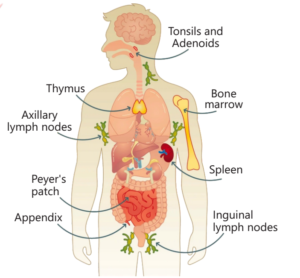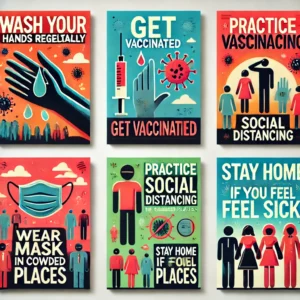UNIT NO.3
Immunity and Diseases
(Solved Exercise)
3.2 Give short answers.
1. Define the following:
(a) Pathogen
Microorganisms that cause diseases in human body are called pathogens.
(b) Antigen
An antigen is a substance, present on pathogens, that activate an immune response by stimulating the production of antibodies.
(c) Infection
Entry and growth of pathogens into our body is called infection.
(d) Phagocytosis
Phagocytosis is a cellular process of ingesting and eliminating foreign substance and microorganisms.
3.3 Answer the following questions
1. Describe the physical barriers against the pathogens in human body.
Our skin, mucous membranes, hairs, cilia, saliva, etc., make the first line of defence against infections. They act
as barriers to the entry of foreign organisms into body cells. Human skin has an outer multilayered thick cover
of mostly dead cells called epidermis. The dead cells of epidermis keep on shedding and expelling the pathogens away from skin. A pigment called melanin is present in epidermis. It darkens skin and protects us from harmful effects of sunlight.
The moist linings of body organs / cavities like mouth, nose, lungs, stomach, etc., are the membranes which produce a thick fluid called mucus. These linings are thus called mucus membranes. The mucous traps foreign organisms (pathogens) and stops their entry into the body cells.
The hairs in nose filter out the dust, pollutants and microbes, etc., from the air breathed into trachea and lungs. Cilia lining the nostrils, nasal cavity and pharynx send these particles to digestive system. Saliva in the mouth (oral cavity) has antiseptic properties and kills the microorganisms in the food. It also washes the teeth and oral cavity. Constant blinking of eyes and tears also flushes and wipes away the pathogens.
2. Explain the non-specific defence against pathogens in human body.
Nonspecific defence includes phagocytosis, inflammatory response, fever and complementary reactions, etc.
Phagocytosis
Phagocytosis is a cellular process of ingesting and eliminating foreign substance and microorganisms. A type of white blood cells called phagocytes perform this function.
Inflammatory Response
When a body tissue is damaged or injured, it causes inflammation. Heat or burning effect, pain, redness, swelling, loss of function, etc., are the signs of inflammation. Inflammatory response is a part of the body’s defence mechanism in which special cells called inflammatory cells are sent at the affected site. They remove the harmful foreign substances / pathogens from the site and begin the healing process.
3. Give brief introduction of pathogens (virus, bacteria, fungi). Explain how can they enter human body?
Viruses
Viruses are tiny particles which can cause infectious diseases. A complete virus is composed of the genetic
material called genome covered by a coat called capsid. In some cases an additional coat called envelope is also present around the capsid. Capsid is the protective coat made of proteins. Envelope, where present, is often covered with spikes that help to identify the host cell.
A virus after invading a host cell uses components of the host cell and replicates rapidly for producing more and more viruses of its own kind. On completion of replication cycle, the new
viruses damage the host cell and are released to invade the other cells of the host body. In this way, the host cells are damaged and destroyed rapidly. The diseases caused by viruses in human are AIDS, COVID-19, hepatitis, polio, common cold, measles, etc.
Bacteria
Bacteria are single celled microorganisms found in every type of environment. A bacterial cell is simply a nucleoid or DNA without any nuclear membrane present in the cytoplasm surrounded by a plasma membrane and an outer protective cell wall. Some bacteria have protective capsule over the cell wall. Ribosomes are the sites for protein synthesis.
One or more flagella help the cell to move. Pili can help certain bacteria attach with host cell. One or more flagella help the cell to move. Pili can help certain bacteria attach with host cell. Cholera, diarrhea, typhoid, tuberculosis, tetanus, etc., are the diseases caused by bacteria.
Fungi
Fungi are simple organisms that can be single celled or multicellular. They cannot make their own food as fungal cells don’t have chlorophyll. They often grow on dead bodies or decaying matter. A typical fungal cell contains a true nucleus, mitochondria, endoplasmic reticulum and golgi apparatus. They have thick walls. The organism’s body consists of filaments called hyphae. Fungi reproduce by means of spores. Yeast, mould, mushroom, etc. are examples of fungi.
Athletes foot, jock itch, ringworm, etc., are the diseases caused by fungi.
4. What are infectious diseases? Give examples.
Infectious diseases are those which are caused by the entry and growth of pathogens in the body of an individual. Viruses, bacteria, fungi and other parasites are the pathogens causing infectious diseases.
The diseases caused by viruses in human are AIDS, COVID-19, hepatitis, polio, common cold, measles, etc.
Cholera, diarrhea, typhoid, tuberculosis, tetanus, etc., are the diseases caused by bacteria.
Athletes foot, jock itch, ringworm, etc., are the diseases caused by fungi.
5. Describe the parts of immune system.
The organs involved in immune system are found throughout the body and work to produce ‘lymphocytes’ and are thus known as lymphoid organs. Lymph nodes, thymus, spleen, bone marrow, tonsils, adenoids, appendix and peyer’s patches, etc., are the organs called lymphoid organs.
Lymph nodes
Lymph nodes are small glands that contain immune cells and found in different parts of the body. When foreign invader enters the body, lymph nodes are activated. They replicate themselves, analyze the foreign body, produce
specific lymphocytes and send them to fight off the invader (pathogen).
Thymus
Thymus is found in the upper part of the chest, beneath the breast bone. It facilitates maturation of ‘T lymphocytes’ which provide cell mediated immunity. The specific task of thymus is to learn, recognize or remember the invader and initiate for the production or selection of T lymphocytes so that their attack can be quickly mounted the next time this invader is encountered.
Spleen
Spleen is purple coloured organ, found in the upper region of left abdomen and protected by rib cage. It stores white blood cells that defend human body against foreign invaders. It filters the blood to destroy old and damaged red blood cells.
Bone marrow
Bone marrow inside the bones produces billions of new blood cells every day and releases them into the blood stream. Bone marrow has stem cells which differentiate into specific cell types, red blood cells, white blood cells, platelets and many other types of immune cells. It strengthens the immune system in our body.
Tonsils
Tonsils are a pair of soft tissues present inside the throat that fight against the infections. They swell up in response to infection.
Adenoids
Adenoids are a patch of soft tissues located behind the nasal cavity. Like tonsils, they help to keep the body healthy. They trap harmful bacteria or viruses we breathe in or swallow. They are important infection fighters in babies and young children.
Appendix
Appendix is a pouch like organ between the small intestine and large intestine. It helps in the maturation of B lymphocytes and takes part in the production of some antibodies.
Peyer’s patches
Peyer’s patches are the lymphoid tissues present in small intestine. They form an important part of immune system for preventing the growth of pathogenic bacteria in the intestines.
6. How can we avoid infections?
Understanding the ways microorganisms enter our bodies can help to prevent infection. The best way to avoid infection is to keep our bodies and environment clean. Following are some ways that help to prevent infection:
1. Dirty hands are major source of germs. The germs enter into our body, when we touch our eyes, nose and mouth
with dirty hands. Wash your hands before you eat, after you use washroom/toilet, and whenever you touch
something used by a sick person.
2. Take a bath at least once a day.
3. We can protect ourselves from food infections by eating healthy and fresh food that is free of germs. Wash fruit and vegetables before eating. Avoid eating items that are not properly covered from dust.
4. Keep our home, school and surrounding clean.
5. Clean cuts and bruises in the skin right away with soap and clean water. Covering the wound with bandage also helps to keep infection away.
6. Learn principles of good health and act accordingly.
3.4 Constructed Response Questions
1. What do you think are the modes of transmission of diseases?
Answer:
1. Touching: Germs can move from one person to another when they touch each other. This can happen when you shake hands, hug, or share things like toys or pencils.
2. Coughing and Sneezing: When someone coughs or sneezes, tiny droplets from their nose or mouth can carry germs through the air. If you breathe in these droplets, you might get sick.
3.Contaminated Objects: Germs can live on surfaces like doorknobs, tables, or toys. If you touch something that has germs on it and then touch your face, you could get sick.
4. Insects and Animals: Some diseases are spread by bugs like mosquitoes or ticks, or by animals like rats. These bugs or animals can carry germs and pass them on when they bite or touch people.
5. Dirty Water: If water is not clean, it can have germs in it. Drinking or swimming in dirty water can make you sick.
6. Food: Sometimes, germs can get into the food we eat. If food isn’t cooked or handled properly, it can make us sick when we eat it.
2. What do mean by personal hygiene? Describe some basic principles in this regard.
Answer:
1. Washing your hands with soap and water regularly is very important. Wash your hand before eat, after you see washroom/toilet, and whenever you touch something used by a sick person.
2. Take bath at least once a day.
3. Wash fruits and vegetables before eating.
4. Wearing clean clothes every day helps to keep you fresh and prevents the spread of germs. Change your underwear, socks, and other clothes daily.
3. Illustrate and give brief introduction of lymphoid organs.
For brief introduction see Q. 3.3/5

3.5 Investigate how can we strengthen our immune system?
We can strengthen our immune system by following methods
1. Maintain a Healthy Diet : Consume a balanced diet rich in fruits, vegetables, lean proteins, whole grains, and healthy fats to provide essential nutrients.
2. Regular Exercise : Engage in moderate physical activity to improve circulation and promote overall immune health.
3. Adequate Sleep : Aim for 7–9 hours of quality sleep each night to support immune function and recovery.
4. Manage Stress : Practice relaxation techniques like meditation, yoga, or deep breathing to reduce chronic stress, which weakens immunity.
5. Stay Hydrated and Avoid Harmful Habits : Drink plenty of water and avoid smoking or excessive alcohol consumption to support optimal immune function.
3.6 Make placards to create awareness against infectious diseases.
